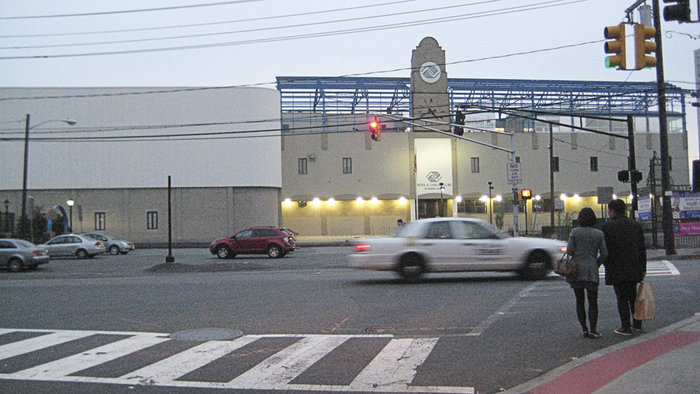Since the beginning of spring and the 2012 hurricane season, residents in the low-lying communities of Paulus Hook and Van Vorst Park have braced themselves for a repeat of 2011.
It was about this time last year that Hurricane Irene dropped between five and eight inches of rain on the area, leaving many residents in these flood-prone neighborhoods with several feet of water in their homes. Since then these residents have been lobbying the City Council and the Jersey City Municipal Utilities Authority (MUA) for a permanent solution to a problem that has plagued this area for at least six decades.
City officials now believe they have come up with a long-term flood mitigation plan that will alleviate flood problems in Van Vorst, Paulus Hook, and flood-prone neighborhoods near the Hackensack River.
Outdated system
Like many cities in the Northeast and Great Lakes region, stormwater in Jersey City drains into the same underground system of pipes as effluent from sewage systems. This is known as a “combined” sewer system.
In the event of major rainstorms, combined systems can become overwhelmed. Flooding can be exacerbated if sewage pipes are poorly maintained and clogged and if green spaces have been paved over due to new construction and development. (Environmentalists like Hackensack Riverkeeper Bill Sheehan, based in Secaucus, point out that natural earth that has not been paved serves as a natural drainage system for floodwaters.)
‘The less water that gets backed up into the interceptor, the less water will be backed up into people’s basements.’ – Dan Becht
____________
The EPA had threatened to sue the MUA for failure to comply with the federal Clean Water Act and its state-issued permit for its combined sewer system. However, as a result of the consent decree, the two parties avoided litigation and the MUA has agreed to take steps to be in compliance with the requirements of its combined sewer system permit and the Clean Water Act.
The deadline for the corrective measures is 2021.
The city was also required to pay a civil penalty of $375,000.
Unclogging the pipes
“There are three projects that we are currently working on that we believe will have a major impact on alleviating flooding in the downtown area,” said MUA Executive Director Dan Becht.
First, the city is currently cleaning its major interceptor, which, Becht said, “will clean out all the filth and debris that potentially blocks the passage of sewage through out pipes.”
The city’s sewage pipes feed into this interceptor, according to MUA Engineer Rich Haytas, which begins at 18 Street and Coles and snakes through downtown and ends at a plant located behind Liberty Science Center.
To give a sense of the type of debris that has clogged the interceptor for years, Haytas said the outside contractor doing the work has discovered a lot of construction debris that was illegally dumped into the sewage system.
“At Provost they found a two-foot blockage that was determined to be concrete,” said Haytas. “It was almost like a dam. It was about 300 feet [long]. This is stuff that was pushed into our pipes from construction projects. Bulldozers must have just plowed everything into the sewer system.”
Becht noted that the main interceptor is about five feet in diameter. Since the chunk of concrete found was roughly two feet in height, almost half of the interceptor pipe was blocked.
New life for old treatment plant?
The city is also exploring the possibility of reopening an old treatment plant near Liberty Science Center to store storm water after major storms. The plant, Becht said, would not treat the storm water runoff. Instead, the plant would simply be used as a retention center to hold storm water.
“We have the capacity to store approximately eight million to 12 million gallons of water, which we could hold until a storm subsides, and then we could send it back to Passaic Valley for treatment,” Becht explained. Essentially, the plant is able to handle runoff from a 10-year storm.
Currently such storm runoff is discharged out to the Hudson River, which can then lead to flooding into residents’ homes.
The MUA recently met with representatives from the New Jersey Department of Environmental Protection and the U.S. Environmental Protection Agency to request the necessary permits to begin to implement this plan. Before this plant can be reopened both the EPA and DEP must give authorization.
Becht described the two agencies as being “very receptive” to the solutions proposed by the MUA.
Pump it out
Finally, the city might also install two pumps at the end of Essex Street that would enable the MUA to quickly pump water into the Hudson River during major storms. This, according to Becht, would reduce the amount of water flowing into the city’s interceptor.
“The less water that gets backed up into the interceptor, the less water will be backed up into people’s basements,” he said.
These two pumps 40-hoursepower will be placed underground, although there will be a control panel above ground, possibly near the Colgate clock.
The pumps, which have yet to be purchased by the city, will cost an estimated $100,000 to $200,000 to buy and install. Haytas said the city will likely rent the pumps over the next 10 to 12 months and purchase them later.
The cleaning of the interceptor will cost about $4 million, most of which is coming from the New Jersey Superfund Trust Fund.
At present, Becht said there is no dollar estimate for how much it will cost to reopen the old water treatment facility for water retention.
“We’re still trying to get cost estimates for that,” said Becht.
However, he hopes the city will be able to borrow whatever money is needed from the Infrastructure Trust Fund.
E-mail E. Assata Wright at awright@hudsonreporter.com.
